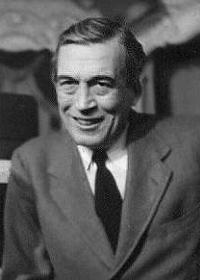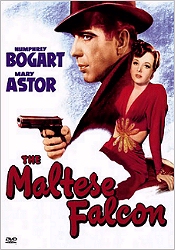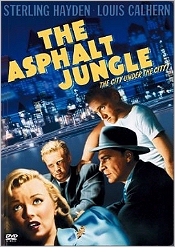 Director, screenwriter, and actor, John Huston was among the first wave of talented writer-directors to come into prominence in the early 1940s, and made many of Hollywood's most admired films during a long directorial career that spanned more than 45 years. Son of actor Walter Huston, he began and ended his life as an actor. Huston made his stage debut at the age of three and worked quite often with his father on the vaudeville circuit in his youth. He became a professional stage actor in his late teens, enjoying some success, and then made his film debut as an actor in a small role in William Wyler's The Shakedown (1928).
Director, screenwriter, and actor, John Huston was among the first wave of talented writer-directors to come into prominence in the early 1940s, and made many of Hollywood's most admired films during a long directorial career that spanned more than 45 years. Son of actor Walter Huston, he began and ended his life as an actor. Huston made his stage debut at the age of three and worked quite often with his father on the vaudeville circuit in his youth. He became a professional stage actor in his late teens, enjoying some success, and then made his film debut as an actor in a small role in William Wyler's The Shakedown (1928).
He went on to appear in two other early sound features but walked away from acting to become a short-story writer and a reporter. Huston continued his career changes throughout the early to mid-1930s, collaborating on several screenplays, most notably two that starred his father, A House Divided (1931) and Law and Order (1932). Finally, after short stints as a magazine editor and, again, as a stage actor, Huston returned to Hollywood to begin his film career in earnest.
He tried his hand at screenwriting again. This time he had a real impact, collaborating on the screenplays of a number of major hits, among them the Bette Davis vehicle Jezebel (1938), The Amazing Dr. Clitterhouse (1938) and Dr. Ehrlich's Magic Bullet (1940), both starring Edward G. Robinson, and Sergeant York (1941) with Gary Cooper. His most important early screenplay, though, was for High Sierra (1941) starring Humphrey Bogart. He had struck a deal with mogul Jack Warner that he would be allowed to both write and direct a movie of his own if the film was a success. High Sierra was, of course, a smash hit, and Huston had his chance.
 For his first film as a writer-director, Huston decided to remake Dashiell Hammett's The Maltese Falcon, a novel that had been turned into a film twice before. With perfect casting, tight direction, and adroit screenwriting (he was the first to realize that Hammett's dialogue was perfectly suitable for the screen), Huston turned The Maltese Falcon (1941) into one of Hollywood's all-time classics.
For his first film as a writer-director, Huston decided to remake Dashiell Hammett's The Maltese Falcon, a novel that had been turned into a film twice before. With perfect casting, tight direction, and adroit screenwriting (he was the first to realize that Hammett's dialogue was perfectly suitable for the screen), Huston turned The Maltese Falcon (1941) into one of Hollywood's all-time classics.
He directed two more films of only modest distinction before World War II broke out and he headed off to war as a filmmaker in the Signal Corps. On returning to Hollywood, Huston made what many consider his greatest film, The Treasure of the Sierra Madre (1948). One of the first films of the stuidio era to be made largely on location (in Mexico), the movie brought Huston's father an Oscar for Best Supporting Actor and earned the director his only Academy Award.
The decade following The Treasure of the Sierra Madre was a rich and rewarding one for Huston. During that time he made many of his best movies, among them Key Largo (1948), The Asphalt Jungle (1950, for which he was nominated for an Oscar for Best Director), The Red Badge of Courage (1951), The African Queen (1951, for which he was again nominated), Moulin Rouge (1953, for which he gained yet another nomination), Beat The Devil (1954, a later-day cult favorite), Moby Dick (1956, an ambitious undertaking that was much better than critics of the day realized), and Heaven Knows, Mr. Allison (1957, an underrated minor masterpiece that had much in common with his earlier African Queen.
 1956 was a turning point in Huston's career; Moby Dick was harpooned by the critics and sank at the box office. As he was used to one hit after another, Huston's erratic commercial success in the late 1950s and 1960s seemed like a fall from grace. But very good movies were to be found as well, a few of them hits, during that period: The Unforgiven (1960), The Misfits (1961), The Night of the Iguana (1964), and Casino Royale (1967)--all had much to recommend them.
1956 was a turning point in Huston's career; Moby Dick was harpooned by the critics and sank at the box office. As he was used to one hit after another, Huston's erratic commercial success in the late 1950s and 1960s seemed like a fall from grace. But very good movies were to be found as well, a few of them hits, during that period: The Unforgiven (1960), The Misfits (1961), The Night of the Iguana (1964), and Casino Royale (1967)--all had much to recommend them.
In spite of these successful movies, it seemed as if the great director was in serious decline. But Huston fooled those who thought his best days were behind him when he directed one of the finest films about boxing ever made, Fat City (1972). Suddenly rediscovered, Huston went on to make, among other movies, the much-admired The Man Who Would Be King (1975), the art-house hit Wise Blood (1979), and Prizzi's Honor (1985), for which he won his fifth Oscar nomination for Best Director, and for which his daughter, Anjelica Huston, won an Oscar for Best Supporting Actress.
The final film Huston directed was James Joyce's The Dead (1987), a lovely effort that served as a fitting end to an illustrious career. But John Huston was not content to stop working. He acted far more often in his later years as a much-in-demand character actor, and in addition to making appearances in some of his own films, he also acted in others, including The Cardinal (1963), Candy (1968), Chinatown (1974), The Wind and the Lion (1975), and Winter Kills (1979). His last performance was in his son Danny Huston's Mr. North (1988), but he collapsed during the production and asked Robert Mitchum to replace him. John Huston died of emphysema before the picture was completed.
--SCOTT & BARBARA SIEGEL, from
The Encyclopedia of Hollywood.